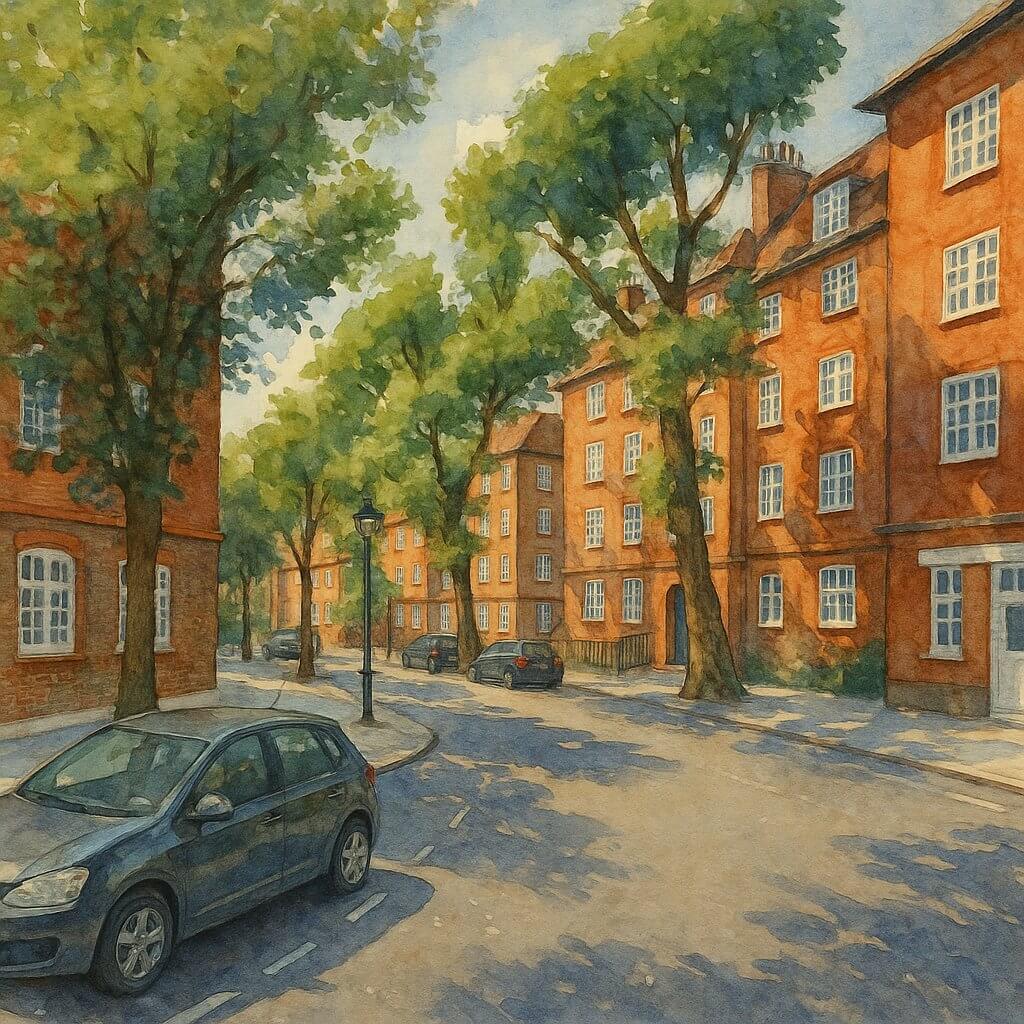
Herrick Street, London
Herrick Street, Westminster SW1: A Hidden Residential Lane in Millbank
Herrick Street is a short residential street located in the Millbank neighbourhood of the City of Westminster, Central London.
It runs from Cureton Street in the south to the junction of Marsham Street and Erasmus Street in the north, nestled within a pocket of quiet roads just west of the River Thames and south of Westminster Abbey.
Length and Layout
Herrick Street is approximately 100 metres (328 feet) long. It’s a narrow, two-way residential road with limited vehicular traffic, bordered on both sides by low-rise postwar housing blocks that are part of the broader Millbank Estate.
The street is mostly used by local residents, with pedestrian pathways leading through to nearby streets and open spaces.
The History of Herrick Street
Herrick Street was laid out in the early 20th century, though much of the area was rebuilt or restructured during the mid-20th century as part of postwar redevelopment efforts in Westminster. It forms part of the wider Millbank Estate, a significant housing development first constructed by the London County Council in the early 1900s.
Much of the surrounding neighbourhood—including Cureton Street, Erasmus Street, and Herrick Street itself—was developed with the intention of providing stable housing for working-class Londoners, replacing the Victorian-era slums that once stood in the area.
How Did Herrick Street Get Its Name?
The street is believed to be named after Robert Herrick (1591–1674), a notable English poet and clergyman known for his lyrical poetry and association with the Cavalier poets. The naming reflects a trend in Westminster of naming smaller streets after literary or historical figures.
The street's naming likely occurred during the original Millbank Estate development period in the early 20th century, though exact council records of the naming date are not publicly available.
Pronunciation Guide
Herrick is pronounced HEH-rick, with emphasis on the first syllable. The standard IPA pronunciation is /ˈhɛrɪk/  .
.
Common misspellings include "Herick" or "Herric", but these are incorrect. Locals and taxi drivers familiar with Westminster typically pronounce it correctly due to its association with the estate.
The Character of the Street
Herrick Street has a quiet, local feel, distinct from the more trafficked roads nearby such as Marsham Street or Horseferry Road. The buildings are modest and predominantly residential, with a strong community-oriented atmosphere.
The architecture reflects the functional postwar aesthetic, with several four- to six-storey brick housing blocks built by local authorities and now largely maintained by Westminster City Council or owned under long-term leaseholds.
Real Estate and Property Sizes
As of May 2025, the typical property on Herrick Street sells for approximately £550,000 to £650,000 for a two-bedroom flat, with the average unit being around 700–750 sq ft (65–70 sq metres).
This is significantly lower than the Westminster borough average, which as of early 2025 is around £1,050,000, reflecting the street’s location within a public housing estate and the absence of luxury amenities.
Rental prices range from £2,000 to £2,400 per month for a 2-bedroom flat, making it relatively affordable by Central London standards.
Nearest London Underground Stations
Herrick Street is conveniently located within walking distance of several key London Underground stations:
- Pimlico Station (Victoria line) – approximately 8 minutes’ walk to the southwest.
- St James's Park Station (District and Circle lines) – about 10 minutes’ walk to the northeast.
- Westminster Station (Jubilee, District and Circle lines) – about 15 minutes’ walk to the northeast, across Millbank and past Parliament.
This connectivity makes Herrick Street surprisingly well-placed for commuters and visitors alike, despite its secluded residential setting.
Fun Fact
Just around the corner from Herrick Street lies the Tate Britain art gallery, one of the most important institutions in the UK for British art. Residents of Herrick Street can walk there in under 5 minutes, making it a hidden gem for art lovers.
Additionally, the area once housed Millbank Prison, a sprawling 19th-century penitentiary that predated the estate and was demolished in the 1890s. The estate and its streets, including Herrick Street, were built on its former footprint.
Quick Facts
- Location: Millbank neighbourhood, City of Westminster, London SW1
- Connects: Cureton Street (south) to Marsham Street/Erasmus Street (north)
- Length: ~100 metres (328 feet)
- Pronunciation: HEH-rick /ˈhɛrɪk/
- Named After: Poet Robert Herrick (1591–1674)
- Character: Quiet, residential, part of Millbank Estate
- Average Property Price (May 2025): £550,000–£650,000
- Property Sizes: ~700–750 sq ft (65–70 sq m)
- Nearest Tube Stations: Pimlico (Victoria), St James’s Park (District, Circle), Westminster (Jubilee, District, Circle)
- Nearby Landmark: Tate Britain, Millbank Millennium Pier
Map of Herrick Street, London

Square painting of Herrick Street, London (View image in full size)